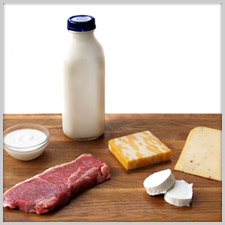Heart & Stroke Health Check™ nutrient standards for fat
Heart&Stroke Health Check™ is a food information program with nutrient standards based on Canada's Food Guide. The Health Check symbol can help you choose foods in grocery stores and restaurants that can be part of a healthy diet. Each food product and restaurant dish in the Health Check program is evaluated by the Heart and Stroke Foundation's registered dietitians on the basis of fat, sodium, fibre and sugar as well as protein, vitamins and minerals, depending on the item. All participating food manufacturers and restaurateurs must meet these nutrient standards in order to display the Heart&Stroke Health Check symbol. Here are the nutrient standards for fat.
Fat
The types of fats found in foods can be confusing to you as a shopper. Product labels claim foods to be all the better for being low in fat, or having reduced fat. And sometimes cutting the fat does make a food healthier, but not always. Certain fats have positive – indeed, vital – characteristics, says Carol Dombrow, the Heart and Stroke Foundation's registered dietitian for Health Check. Healthy fats are important to the body's ability to absorb vitamins such as A, D, E and K. "Healthy fats," she says, "not only increase your feeling of fullness, but also supply the body with necessary nutrients."
Healthy Fats

Healthy oils include olive, canola and peanut
Healthy fats come in the form of monounsaturated and polyunsaturated fats. These fats can lower bad cholesterol levels (LDL cholesterol). Monounsaturated fats have been shown to improve blood cholesterol levels. They're found in olive oil, canola oil, peanut oil, non-hydrogenated margarine, avocados and some nuts such as almonds, pistachios, cashews, pecans and hazelnuts. One type of polyunsaturated fat is omega-3, which can help prevent clotting of blood, reducing the risk of stroke and also helps lower triglycerides, a type of blood fat linked to heart disease. The best sources of omega-3 fat are cold-water fish such as mackerel, sardines, herring, rainbow trout and salmon, as well as flaxseed and walnuts.
Another type of polyunsaturated fat is omega-6. It helps lower LDL cholesterol, but in large amounts it's thought to also lower the good HDL cholesterol. Eat it in moderation. It's found in safflower, sunflower and corn oils, non-hydrogenated margarine and nuts such as almonds, brazil nuts and sunflower seeds. It is also in many prepared meals.
Unhealthy Fats

Saturated fats are present in animal producs such as meats, milk, cheese (from cows and goats) and yogurt
Eating a diet high in saturated fats can raise bad cholesterol (LDL). While the liver makes about 80% of the cholesterol in the body, the other 20% comes from the foods you eat. The foods that raise your blood cholesterol the most are saturated fat and trans fat.
The highest levels of saturated fats are found in fatty meats, full-fat dairy products such as cream, butter and cheese, and some oils (such as palm and coconut).
From a nutrition perspective, the best way to control blood cholesterol is to eat a healthy diet that is lower in fat, especially saturated and trans fat.
That's why it's important to choose lean cuts of meat, lower-fat milk, cheeses and yogurt.
Artificial trans fats

Trans fat can be found in hard margarine, pastries, doughnuts and crackers
Artificial trans fats are the most hazardous kind. When you eat artificial trans fats, they increase your bad LDL cholesterol levels and decrease your good HDL cholesterol levels. That is why Heart&Stroke Health Check program has revised its trans fat guidelines by strictly limiting acceptable amounts. Artificial trans fats are created in a process called partial hydrogenation, a procedure that turns a liquid into a semi-solid. Beware of trans fats in packaged products such as crackers, cookies, baked goods, fried and fast foods. Although trans fats are found naturally in small amounts in beef, lamb and some dairy products, nutrition experts believe that they do not to have the same unhealthy effect as artificial trans fats.
Heart&Stroke Health Check nutrient standards for fats
Fats are found in most food groups, with the exception of fresh fruits and vegetables. It's best to choose products that are either low in total fat or are a source of healthy fats and are lower in unhealthy fats such as saturated and trans fats. Foods with the Heart&Stroke Health Check symbol have met these standards for fat and is your assurance that you are making a wise choice.
Participating products in the Heart&Stroke Health Check program must only contain 5% or less of total fats as trans fats, and 2% for margarines and oils. Here are the examples of the fat criterion for different food categories:
| Food category | Health Check Criteria for fat |
|---|---|
| Lower-fat milk | 2% or less milk fat |
| Lower-fat cheese | 20% or less milk fat |
| Low-fat yogurt and other milk products | 3 grams or less of fat |
| Grain products(cereals, breads, tortillas, buns, etc.) | 3 grams or less of fat |
| Lean meats | 10% fat |
| Extra-lean meats | 7.5% fat |
| Lean ground meat | 17% fat |
| Extra-lean ground meat | 10% fat |

